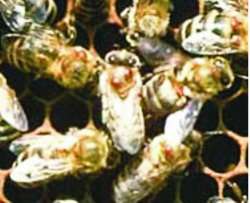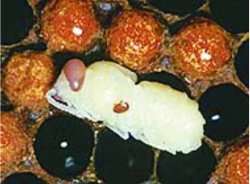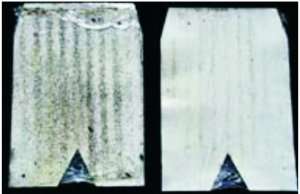“On the 11th of April, 2000, Beekeeping in New Zealand changed forever!”
The strain of Varroa found in New Zealand in April 2000 is the worst strain of this pest called Varroa Destructor and is here to stay. It easily infests hives by jumping from bee to bee within the hive or from flower to bee as bees forage for their food.
Life Cycle of the Varroa Bee Mite:
1. Varroa mites are transferred to new colonies on adult bees.
2. The mite then leaves the adult and crawls into a brood cell, preferably a drone cell, although it will inhabit workers cells.
3. The mite submerges itself in the larval food at the bottom of the cell.
4. When the cell is capped, the mite leaves the larval food and starts feeding on the prepupa.
5. It then lays 5 to 6 eggs, the first of which is usually a male, the remainder being female. The eggs once hatched go through two juvenile stages before taking on the adult body shape.
6. The mites mate in the cell before the host bee hatches. The adult mites leave the cell when the bee emerges. They are then transported on adult bees until they enter another brood cell.
Varroa Mites on Bees:
These nasty pests suck the blood or haemolymph of the bee. This appears to cause changes in the immune components of the haemolymph in the bee, thus eventually weakening the bee and making it more susceptible to viruses possibly passed on by the mites. These mites are feeding on adult worker bees & a drone pupae.
If left uncontrolled, the mites will multiply very quickly, weakening the bees and the overall health of the hive. A beehive can survive reasonably well with very small numbers of mites and to maintain mites at low levels we must treat the beehives in various ways.
The first thing we did was to establish a new integrated pest management strategy which included several changes to the build of the beehive. First, we developed screened floorboards which the mites that are picked off by other bees drop through and cannot re-enter the hive. This ‘mite drop’ can account for up to 20% of mite reduction.
We also reduced the number of drone cells in the beehives by replacing old frames with new ones.
Now that these initial steps have been completed, we simply treat the beehives regularly once or twice a year. Currently we are using Miticide strips, but as other products are registered for use in New Zealand we will begin using these to avoid the risk of resistance.


 UMFHA REGISTERED
UMFHA REGISTERED







